Some Notes on a Lately Acquired Collection
“The owners of these islands,” says an old writer, speaking of the Southern Philippines about a century and a half after Magellan, “are those who people the mountains,” having retreated thither before invasions of more vigorous tribes (Moro), who hold the coasts and “bear themselves among those people as princes.” The Bagobo still “people the mountains” of Mindanao between the crest of the range which culminates in the volcanic Mt. Apo, the highest peak in the Philippines, and the waters at the western side of the head of the Gulf of Davao. They form a population of some ten or twelve thousand, still largely pagan; since the American occupation of the Islands, a considerable number have been induced to settle in the lowlands between their original mountain fastnesses and the coast.
The Bagobo do not seem to differ greatly from other Malays in appearance. They are short and slim, broad-headed and of a light reddish-brown complexion. These characteristics are said to be common to all the tribes about the Gulf of Davao; though individuals are found, especially toward the interior, who show marked traces of intermarriage with Negritos. The Atá, to the north and northeast of the Bagobo, have been called Negritos by some observers; and there are said to be Pygmies in the Samal Islands of the Gulf.
Various phases of the life of these people are well illustrated by many of the objects included in a large collection made among the Bagobo within recent years, and lately acquired by the Museum.
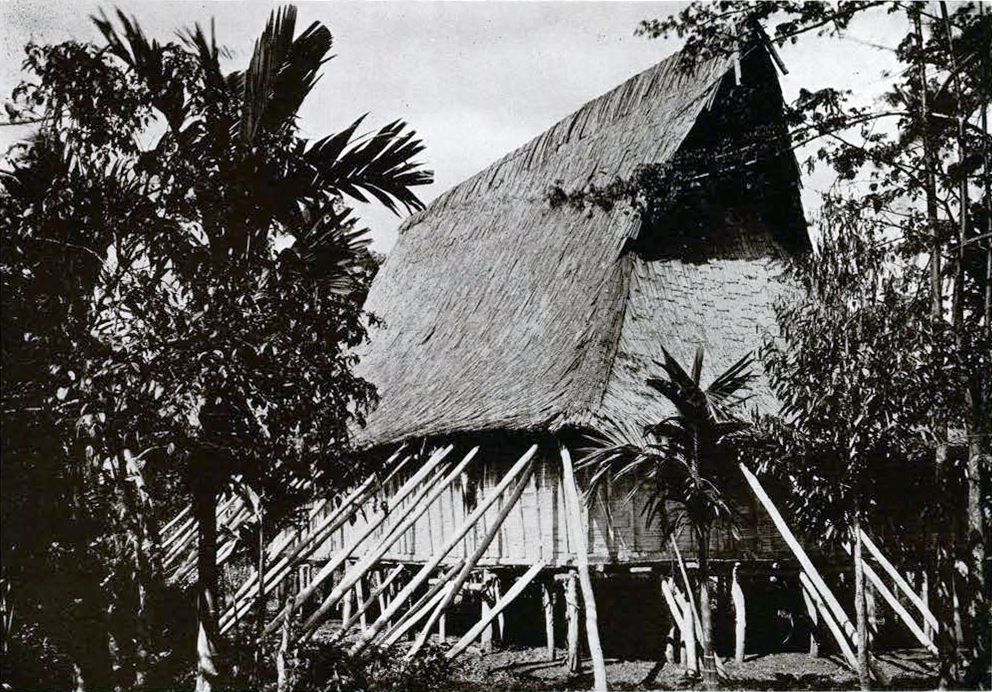
The Bagobo are a settled people, practicing agriculture as well as hunting and fishing. Their chief crop is rice, which they grow in clearings on the mountain sides. Since this grain is their staple food, the whole routine of its cultivation is most closely bound up with their religious beliefs and practices. When, in December, Orion appears in the sky, this is the signal for the celebration of the great yearly sacrifice and for making all things ready for the rice-planting. Offerings of rice cooked in bamboo tubes—pots must not be used for this purpose—are made at the smith’s forge, to which the men bring their working knives and other tools used in connection with the cultivation or clearing of the fields. Then the smith calls on his patron spirit to come and eat of the food and accept the tools here devoted to him. These tools will be used in field work, although they now belong to the spirit, and compensation must be made to him if a knife be sold or otherwise disposed of. For the next three days no man must do any work. At the end of that time the workers go to the fields and set up in the middle of each a receptacle containing an offering of areca nuts intended for Manama, the Creator. In return for this, Manama is expected to keep mischievous spirits out of the field, to grant health, large crops and riches to the owner.
Then, if it is a new field—and the incessant encroachments of cogon grass make frequent new clearings necessary—the trees and brush are cut down and burnt. But no soil must be broken nor any further preparations made for planting until the constellation Marara appears in the sky in April.
Prayers and offerings to Manama and to the food spirit Taragomi precede the actual commencement of planting operations. The rice-planter consists of a long shaft, to one end of which is attached a narrow iron blade, the other end having fastened to it a clapper of split bamboo. The men make shallow holes in the ground with these implements, the women following and dropping into the holes the seed, over which they scrape the loosened soil with their feet. The purpose of the clappers is obscure; perhaps they are intended to frighten away ill-disposed spirits, or it may be that the noise made by them as the planters strike the ground is pleasing to the guardian spirit of the field.

According to the Jesuit Father Gisbert, writing in 1886, a feast accompanied by the sacrifice of a human victim was held before the planting. Dr. Cole is doubtful whether any such sacrifice accompanied the rice-planting ceremonies. Father Gisbert, however, is quite explicit on this point; and from Dr. Cole’s description of “the greatest of all Bagobo ceremonies—the Ginem,” which is stated to be held “within three or four months after the appearance of the constellation Balatik (Orion),” i.e., just about the time when the rice-planting would commence, it appears that a human sacrifice was formerly made as a part of this ceremony. This coincidence in time and certain details of the ceremony, as well as the fact that one of its objects is said to be “to so gratify the spirits that they will be pleased to increase the wealth of all the people,” make it seem more than probable that the Ginem, the “annual sacrifice,” and the rice-planting festival all form part of a series of ritual performances connected with the spring activities looking to the ensuring of an adequate food supply.
According to Father Gisbert, the feast before the sowing, which he describes as “a criminal and repugnant trago-comedy,” was held in the woods. A slave—the victim—was bound and the celebrants performed a sort of wild dance around him, shouting and striking the victim one after another until the body was cut into small pieces. They then repaired to the house of the chief, bearing branches of trees, which “they place in a large bamboo, not only the chief adornment but the altar of the house.” Then followed a feast, at which apparently the only essential formality consisted in the appeal of the datu or chief to “the great demon called Darago.” The datu stood near the bamboo “altar,” holding a vessel of sugar-cane wine, and said : “Darago, we are making you this feast with great good-will and gladness, offering you the blood of the sacrifice which we have made, and this wine which we drink, so that you may be our friend, accompany us, and be propitious in our wars.”
The bamboo “altar” of Father Gisbert is evidently the patannan of Dr. Coles—two poles of bamboo, “one nine, the other eight sections long.” These are decorated with shavings, “strips of palm or bamboo leaves and cloth or palm-leaf streamers.” They are dedicated to Mandarangan and Darago, a male and a female spirit, husband and wife, the patrons of warriors, who dwell in Mt. Apo—the longer pole being that of Mandarangan, the shorter, of Darago. To these poles are attached the skulls of enemies killed in a recent raid. The blood of a chicken sacrificed by the datu or chief magani (warrior) is sprinkled on the poles—this is a modem substitute for the blood of a human victim—and, the sacrifice having been made, the men and boys gather round the poles “and yell lustily.” Food is then partaken of by the company, portions being offered to the supreme being and to various other spirits.
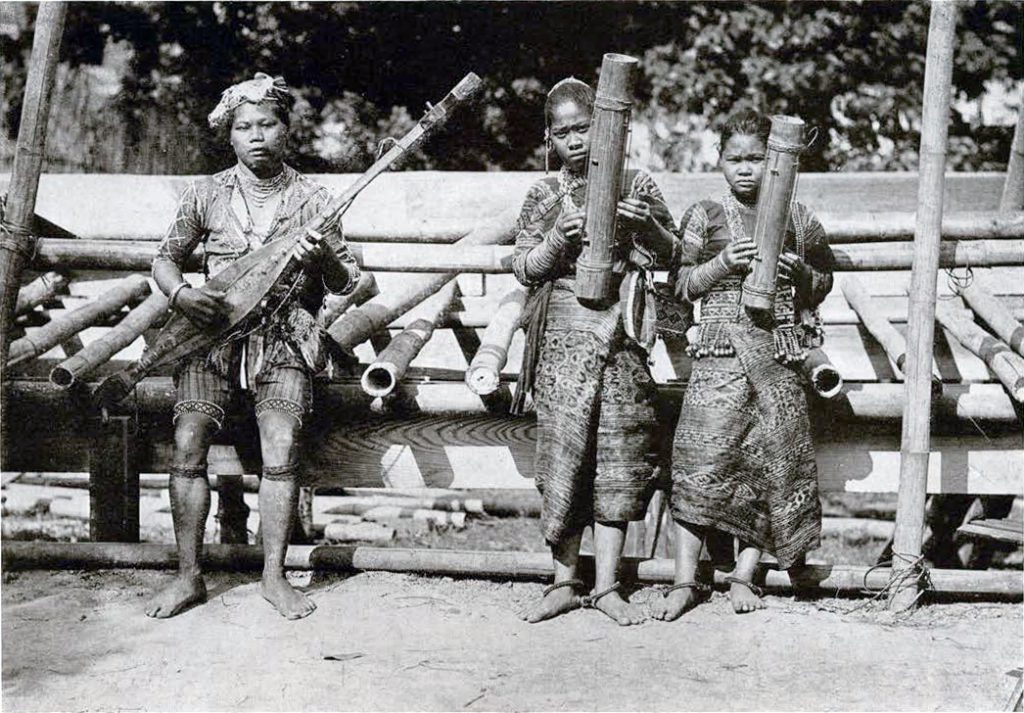
Then the magani, one after the other, holding on to the patannan, recite the warlike deeds they have performed, and enumerate their killings and captives. This is followed by more feasting and by dancing to the music of the agongs.
The second day of the festival is the women’s day, and the mabalian, or shamaness, plays a much more important rôle in the proceedings than on the first day. The women make offerings of garments and of betel to certain spirits, and dance before them to the music of small agongs. Towards the end of the day the mabalian sprinkles the heads of the women with drops shaken from leaves dipped into an old agong filled with water, praying the spirits to give to their worshipers “a good mind and habit.”
The women are the weavers. They make beautiful hemp cloths on a primitive loom of a type found at various points on both sides of the Indian. Ocean from the Congo to Micronesia. A “saddle” of carved wood passes behind the weaver and is attached to a rod in front of her body. From this rod the threads of the warp extend to a bamboo beam fixed horizontally to the wall of the house. The weaver sits on the ground in such a position as to keep the warp threads stretched taut. These have previously been stretched vertically on a bamboo frame and portions of them “reserved” in groups by being wound tightly with hemp fibre according to a regular pattern. The threads are then removed from the tying frame and placed in the dye, so that the uncovered portion takes the desired color. This process may be repeated until a pattern in two or three colors appears on the warp, which is then transferred to the loom.
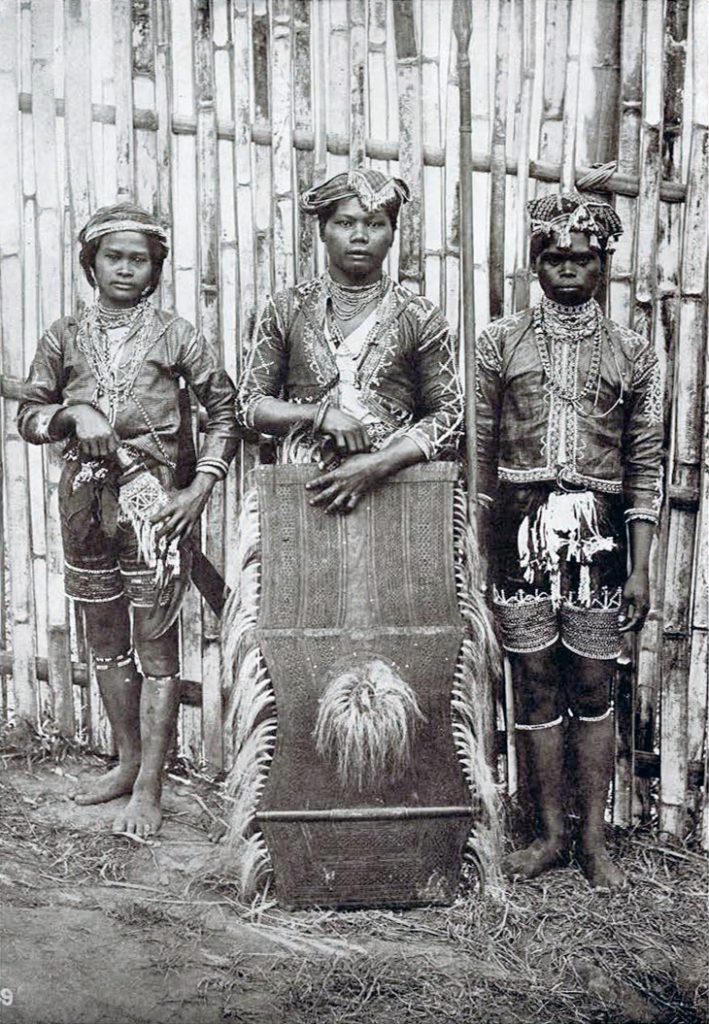
A variant of this method of dyeing is practiced by the Kulaman (Manobo) who live to the south of the Bagobo. They “reserve” a pattern by stitching hemp thread closely on the finished cloth, which is then placed in the dye. When the unreserved portions of the cloth have absorbed the color the piece is removed from the bath and allowed to dry. The stitching having been removed, the reserved pattern appears in the natural color of the hemp fibre. The Bagobo procure this cloth by trade from the Kulaman, as they do also fine embroidered jackets from their other neighbors the Bilaan.
Similar methods of “reserving” portions of the warp, or of the finished cloth, from the dye so as to form a pattern are followed in Africa among some tribes of the Kasai River basin, in Indo-China by the Khmer of Cambodia, and in Java and Borneo. The Igorot loom is almost the counterpart of that of the Bagobo.
A somewhat different mode of reserving a design—on finished cloth—is that used by the makers of the magani’s head-kerchief. This branch of the weaving industry is a specialty of the mabalian or shamaness. The kerchief is woven of cotton thread procured from Chinese traders. It is dyed a dark reddish-brown, after portions of the cloth have been reserved by being caught up and closely overtied with hemp fibre. When the fibres are removed an elaborate pattern outlined in small white rings appears against the red background.
The magani wear suits of hemp cloth dyed a dark red—blood color. A man who has killed two persons becomes, by that act, a magani, and is entitled to wear the kerchief. When he has killed four, he may assume trousers of blood color; and the taking of six lives gives him the right to a complete blood-red suit. The mabalian, on account of their ability to weave and dye the magani’s head-kerchief, are under the special protection of the patron spirit of weavers, and are the only people besides the magani who are allowed to wear garments of linumbus, the blood-red cloth. At any rate, the wearing of this cloth was formerly so restricted, but it seems that the privilege is now extended to other women of rank and to the young sons of chiefs.
The dress of the men consists of a short tightly-fitting jacket, open in front, and very short tight trunks. The women’s jackets are similar in shape to those of the men, but they are closed in front so that they have to be slipped on over the head. The women wear also a tube skirt, of the same width throughout, like a sack. The jackets of both men and women are richly ornamented with shell discs, glass beads or embroidery. The men wear a kerchief, folded and tied, on their heads; a woman’s coiffure is embellished with bead-incrusted combs cut out of wood, from which hang heavy festoons of beads.
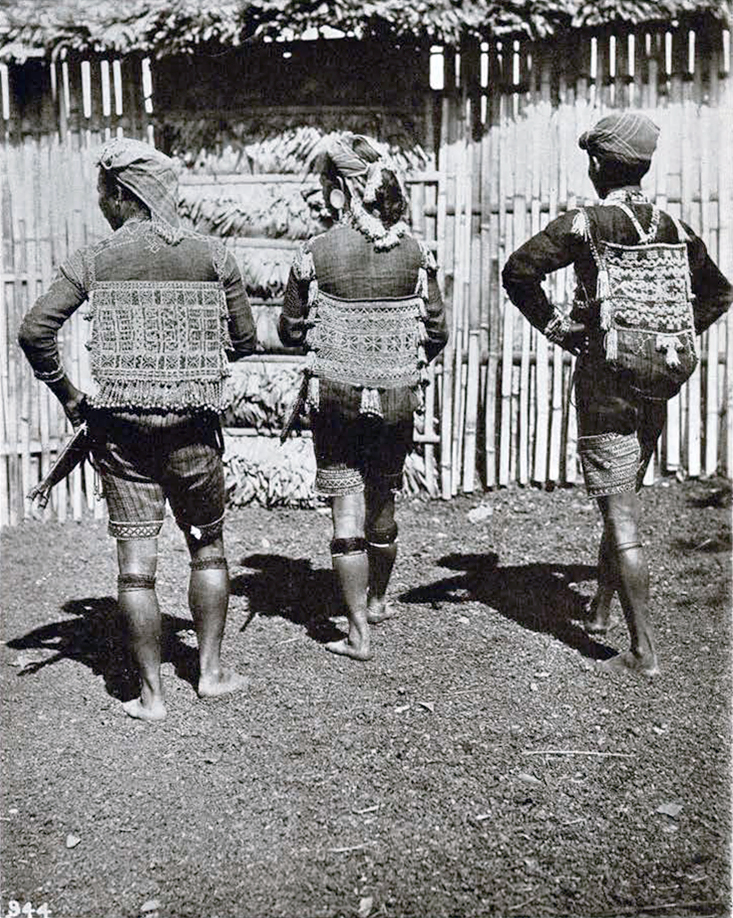
Both men and women wear ear-plugs connected under the chin by numerous varicolored strings of beads. Men who can afford it have their ear-plugs made of ivory imported from Borneo. Chains and strings and woven bands of beadwork hang in great profusion about the necks of both men and women. The large fiat carrying-bags worn by men on their backs and the small trinket-baskets of the women are elaborately ornamented with beadwork also. The effect of the costume with its wealth of brightly colored ornament is strikingly picturesque, and must form, with its wearer, an ensemble admirably in keeping with the tropical conditions of atmosphere and landscape and illumination.
Arms and legs are laden with bracelets and bangles of brass, of shell, of cunningly woven vegetable tendrils and fibres. The art of brass founding, and of casting by the tire perdue process, has evidently been learnt from the Moros, as is shown especially by the examples of brass betel boxes in the collection.
In hunting, besides the ordinary spear or lance, which is also a weapon of war, a harpoon is used. When the head of this weapon enters the body of a running deer, it becomes detached from the shaft, which is thus left dangling by the cord which attaches it to the head, until it becomes entangled in the brush and places the wounded animal at the mercy of the hunter.
Wild fowl are captured by means of a snare used in connection with a decoy bird—a tame rooster, tied to a tree in the jungle and surrounded by a number of running nooses of rattan attached to a cord of the same material. The crowing of the rooster attracts the wild birds, which approach to investigate and become ensnared in the nooses. The trapper carries his rooster to the jungle in a flat basket to which is attached a receptacle for the coiled rattan cord with its nooses.
The principal weapons of the Bagobo warrior are spear and knife. There are several forms of both weapons in the collection; the knives including several fine examples of the typical Malay kris. Shields are either round or oblong. The round shield is practically identical with those carried by some Javanese tribes and by the Maros. They have the bow, but seem to place little reliance on it in warfare. An attack begins with the hurling of spears. This is, however, merely a preliminary to the real combat, which is carried on at close quarters with the knife.
From Father Gisbert’s account, quoted above, of the spring feast before the rice sowing, it would seem that Darago was regarded as the patron of warriors—sacrificed so that he might be propitious to the tribe at war. Father Gisbert goes on to say that the ceremony was concluded by a kind of litany in which were recited the names of “all the most celebrated Daragos.” Elsewhere he says: “There is no rancheria in which they do not annually make their feasts to the demon—Busao, Mandarangan or Darago, for they are wont to give him these and many other names.” Again: Mandarangan lives in Apo “as in his throne of smoke and fire.” From these and other statements about the “gods” and “demons” of the Bagobo, it would appear that there was no little confusion in the mind of the good father as to the names and functions of the divinities in the Bagobo Olympus. His attempt to establish a hard and fast line of cleavage between the Bagobo powers of good and of evil only serves to make this confusion worse confounded, and brings him to the curious conclusion that although they recognize a God who is very good and created all things, yet “they believe that both in this life and in the other they belong to the devil” [Mandarangan, Darago, Busao?], who yet claims only one of the two souls of a man when he dies, the other going “to heaven.” It is this “devil” whom Father Gisbert makes responsible for the human sacrifices, which, he says, are propitiatory or precautionary, intended to avert evil by glutting with blood the author of evil, on the principle, apparently, that “like cures like.”
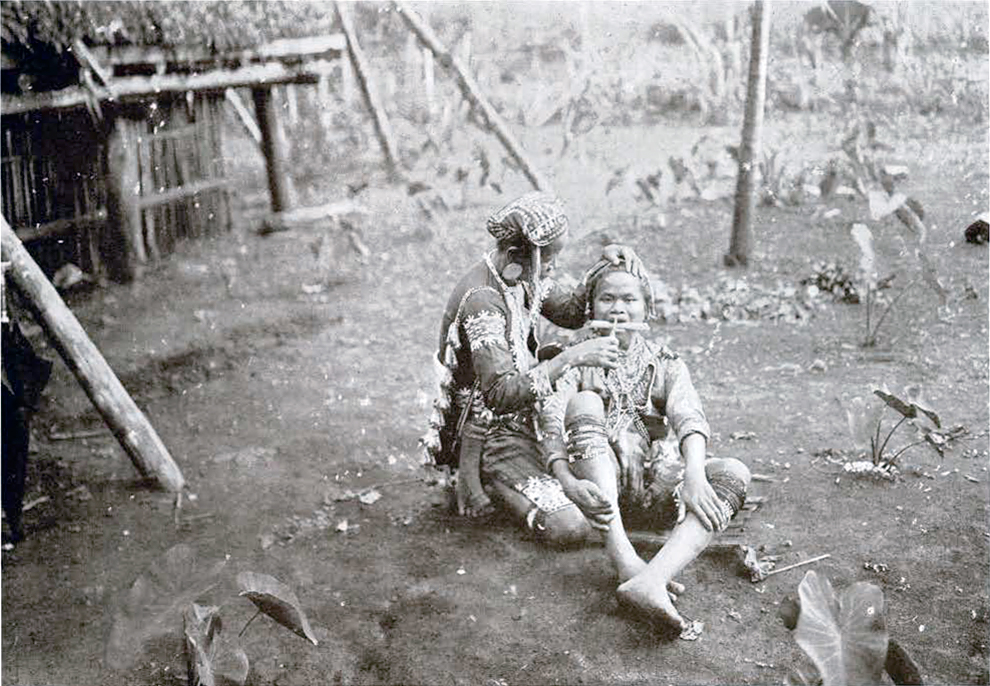
A more consistent and systematic account of Bagobo beliefs is given by Dr. Cole, who, as already mentioned, treats Mandarangan and Darago as two distinct spirits, man and wife. He states definitely that they are the patrons of warriors and, here agreeing with Father Gisbert, dwellers in the “great fissure of Mt. Apo.”
The head of the Bagobo is datu of Cibolan, who has under him minor datu, nominally, at least, subject to his authority. He has, or had until recently, power of life and death over the tribesmen, modified only by his respect for the customary law handed down from the ancestors and binding him in common with the rest of the tribe.
The remainder of the Bagobo belong to two classes—freemen and slaves. Women and children captured in war become the slaves of their captors. But the servile class rapidly tends to become merged with the class of freemen: a woman who bears a child to her master is commonly freed, and in any case her children are regarded as free and legitimate inheritors of their father’s property.
A freeman’s chief ambition is to become a magani, and be known as such by his distinctive garments. The magani’s victims are not necessarily members of a hostile tribe: a man may count two in his score for the slaying of an unfaithful wife and her lover; and even one of his own townsfolk, if killed in fair fight, will go to increase his tally.
The mabalian form a priestly caste consisting principally of women, although men are not barred from its ranks. The call to become a mabalian comes—sometimes at an advanced age—in a vision, or from other mabalian to whom the spirits have designated the person chosen for the office. She is physician, midwife, builder of shrines, conductor of ceremonies, intermediary between gods and men; and, in a society in which prowess as a warrior is the key to social advancement and the gaining of the favor of the gods most courted, she, as is fitting, is the only skilled artificer of the insignia of the fighting man, and alone is privileged to flaunt in her own clothing the glaring tint that marks the man of blood.
H. U. H.

